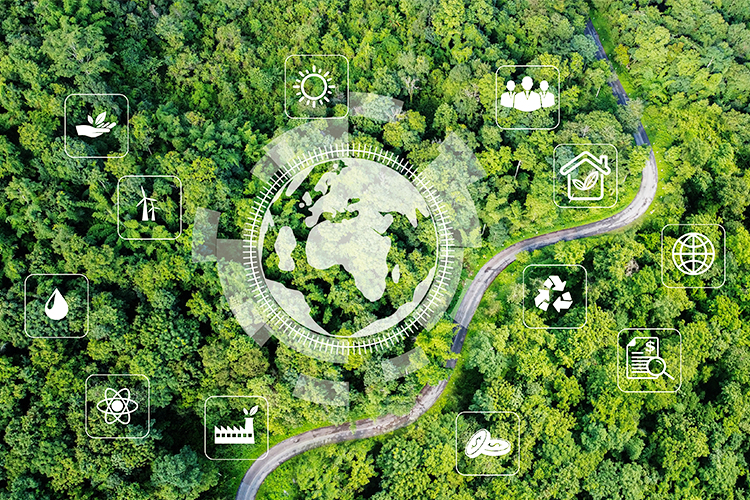Navigating the Sustainability Journey in Business
March 18, 2024
As we progress into 2024 and beyond, a profound shift towards sustainability is underway. The growing emphasis on integrating Environmental, Social and Governance (ESG) considerations into business strategies marks a pivotal shift towards aligning with the long-term prosperity of both our planet and society. Yet, this path is not without its hurdles.
Challenges such as regulatory shifts, stakeholder expectations and fulfilling consumer demands compel businesses to tread cautiously on this sustainability journey. As C-Level and VP-Level executives steer their organizations towards sustainable practices, some pivotal questions arise that determine the trajectory of their initiatives.
Today, let us delve into three critical queries echoing through corporate corridors:
- What exactly is the compelling business case for sustainability?
- How do we measure our current environmental impact accurately?
- How do I mitigate risk when implementing sustainable initiatives?
Making the Business Case for Sustainability
Sustainability has transcended mere environmental responsibility; it now stands as a strategic imperative driving long-term profitability and resilience. While some may harbor doubts regarding ESG investments' financial viability presently, tangible use cases can serve as powerful catalysts for adoption.
Evidence increasingly showcases that companies committed to robust ESG practices can unlock better operational efficiencies, reduced costs and heightened appeal to investors – shaping a resilient and competitive business landscape.
For instance, consider the transformative switch from traditional lighting methods to LED technology. The adoption of LED lighting sees energy consumption plummet by over 50% on average - offering significant reductions in utility costs. This released capital could be redirected towards other crucial areas of business operations thereby amplifying investment capabilities and fostering innovation.
And these advantages are just the tip of the iceberg. Exploring innovative energy-efficient solutions like HVAC UV-C coil cleaning, fleet electrification and smart building controls unveils further opportunities for returns on investment.
Anticipating the ROI in sustainability becomes less of an enigma when equipped with robust payback calculations and case studies from trailblazing companies. These predictive analyses and real-world examples illuminate the path ahead, often revealing that the leap towards sustainable practices is not a leap of faith, but a strategic step grounded in evidence.
Assessing Your Environmental Impact
Whether you're well into your company's sustainability journey or just getting started, grasping your current environmental impact is essential. Establishing this baseline equips you with a critical reference point to gauge progress against as you track the efficacy of your sustainability initiatives over time.
Conducting an energy audit allows you to gauge your footprint and signifies the first step in laying a groundwork for integrating sustainability practices into your ongoing operations. However, it's important to recognize that not all energy audits are created equal. The depth and scope of an audit can vary significantly. A thorough energy audit should encompass not just a straightforward inventory of energy consumption but also an in-depth analysis of energy flow for identifying inefficiencies and areas for improvement.
When choosing a partner to conduct an energy audit, transparency and expertise should be at the foreground of your considerations. Look for entities with a robust track record of conducting comprehensive audits across similar industries. It's also beneficial to select a partner that brings a holistic approach, considering both direct and indirect environmental impacts. Asking for case studies or references can provide insight into their effectiveness and approach.
Furthermore, ensure the audit includes clear, actionable recommendations tailored to your business's specific needs and circumstances, and not just a generic list of best practices. The capability to provide ongoing support in implementing these recommendations and monitoring progress is the hallmark of a valuable partner.
This informed knowledge will empower you to make strategic choices, prioritize sustainable investments wisely and set realistic goals to minimize environmental footprints effectively. The quest for integrating sustainable principles does not only bolster organizational ethos but also garners stakeholder loyalty – positioning your enterprise ahead in the competitive market.
Mitigating Risk
Taking preemptive action to mitigate potential risks associated with sustainability initiatives requires proactive measures. Your company should regularly conduct risk assessments to recognize and tackle any financial, operational or reputational hazards. By anticipating obstacles, you can devise contingency strategies to uphold stability and consistency in your sustainability endeavors. Here are some additional proactive measures you might consider taking to mitigate risk:
- Stay Informed on Regulatory Changes: Keep abreast of local, national and international regulatory changes regarding sustainability to ensure compliance and leverage incentives for sustainable practices.
- Build Stakeholder Trust: Involve stakeholders in the sustainability discussion to ensure their concerns and expectations are addressed, enhancing company reputation and stakeholder relationships.
- Adopt Impactful Technologies and Practices: Leverage technology to improve efficiency, reduce waste and enhance the sustainable operations of the business.
- Engage Employees in Sustainability Efforts: Provide employees with training and resources on sustainability practices to build a knowledgeable workforce that can effectively implement and advocate for these initiatives.
These measures will empower you to anticipate potential challenges and adapt your tactics amid changing market dynamics and regulatory frameworks.
Building Sustainability Over Time
While the road to integrating sustainable technologies and practices may seem fraught with challenges, the rewards far outweigh the hurdles. From enhancing brand reputation to achieving significant operational cost savings, the benefits of a sustainability-oriented approach are multi-faceted.
Remember, these initial steps are just the beginning. They serve to demonstrate that sustainability is not only feasible but also advantageous. By starting with manageable actions, you build momentum and confidence, moving your organization towards more substantial sustainability goals. Every action counts, and by taking these first steps, you're contributing to a larger global effort towards sustainability.


